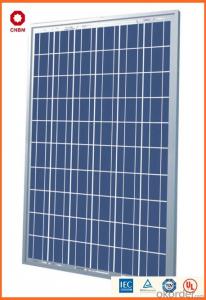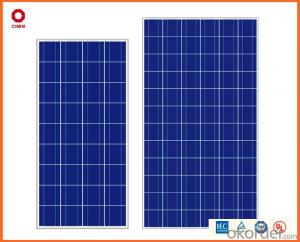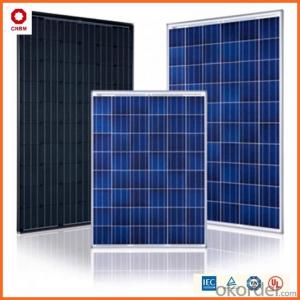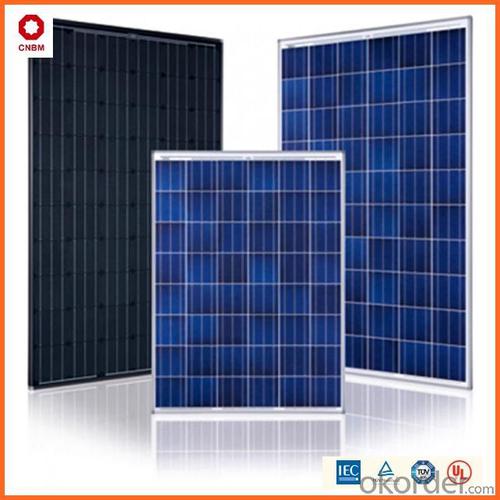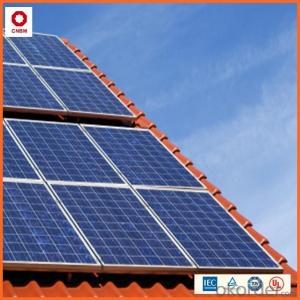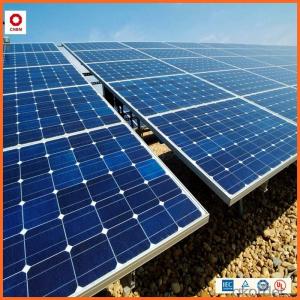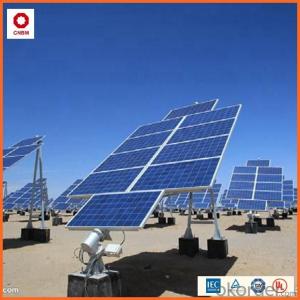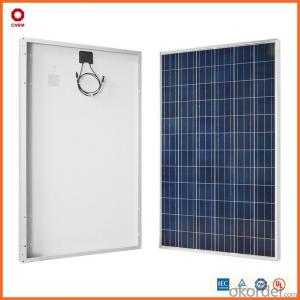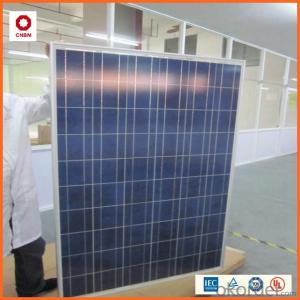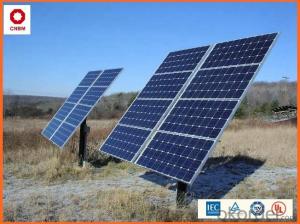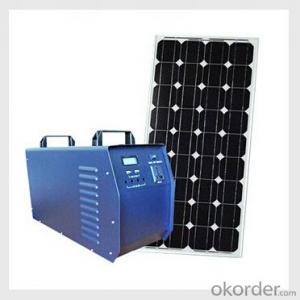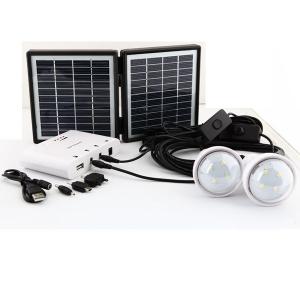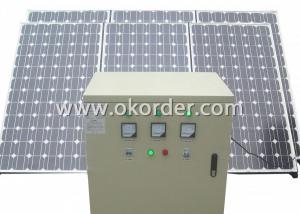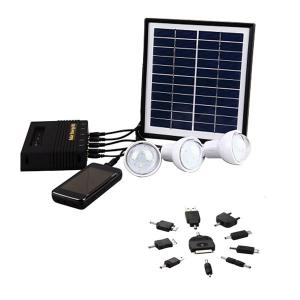Solar Energy Systems:!!! Hot on Sale!!! Stock 265W Poly Solar Panel USD0.45/W A Grade Good Solar Panel
- Loading Port:
- China main port
- Payment Terms:
- TT OR LC
- Min Order Qty:
- 1 watt
- Supply Capability:
- 10000000 watt/month
OKorder Service Pledge
OKorder Financial Service
You Might Also Like
Product Description:
Hot Sale !!! Quality and Safety of 245w-320w Poly Solar Panel
1. Rigorous quality control meets the highest international standards.
2. High-transmissivity low-iron tempered glass, strong aluminium frame.
3. Using UV-resistant silicon.
4. IS09001/14001/CE/TUV/UL
Warranties of 245w-320w Poly Solar Panel
1. 10 years limited product warranty
2. 15 years at 90% of the minimal rated power output
3. 25 years at 80% of the minimal rated power output
Technical date of 245w-320w Poly Solar Panel
ITEM NO.: | Mono 125*125 cell ,36pcs . Power range from 80Wp-100Wp | ||||||||
Maximum Power(W) | 80 | 85 | 90 | 95 | 100 | ||||
Optimum Power Voltage(Vmp) | 17.81 | 17.89 | 17.94 | 17.99 | 18.06 | ||||
Optimum Operatige Current(Imp) | 4.78 | 4.91 | 5.12 | 5.35 | 5.59 | ||||
Open Circuit Voltage(Voc) | 21.98 | 22.05 | 22.14 | 22.28 | 22.45 | ||||
Short Circuit Current(Isc) | 4.95 | 5.15 | 5.36 | 5.65 | 5.84 | ||||
Solar Cell: | 125*125 Mono | ||||||||
Number of Cell(pcs) | 4*9 | ||||||||
Brand Name of Solar Cells | JA Cell, Bluesun Cell | ||||||||
Size of Module(mm) | 1580*808*35 | ||||||||
Caple & Connector Type | Pass the TUV Certificate | ||||||||
Frame(Material Corners,etc.) | Aluminium-alloy | ||||||||
Backing (Brand Type) | TPT | ||||||||
Cell Efficiency for 100W(%) | 15.8% | ||||||||
Weight Per Piece(KG) | 12.0KG | ||||||||
FF (%) | 70-76% | ||||||||
Junction Box Type | Pass the TUV Certificate | ||||||||
Tolerance Wattage(e.g.+/-5%) | ±3%, or 0-3% | ||||||||
Front Glass Thikness(mm) | 3.2 | ||||||||
Temperature Coefficients of Isc(%) | +0.04 | ||||||||
Temperature Coefficients of Voc(%) | -0.38 | ||||||||
Temperature Coefficients of Pm(%) | -0.47 | ||||||||
Temperature Coefficients of Im(%) | +0.04 | ||||||||
Temperature Coefficients of Vm(%) | -0.38 | ||||||||
Temperature Range | -40°C to +85°C | ||||||||
Surface Maximum Load Capacity | 2400Pa | ||||||||
Allowable Hail Load | 23m/s ,7.53g | ||||||||
Bypass Diode Rating(A) | 12 | ||||||||
Warranty | 90% of 10 years,80% of 25 years. | ||||||||
Standard Test Conditions | AM1.5 1000W/ 25 +/-2°C | ||||||||
Packing | carton or pallet | ||||||||
1*20' | 25 Pallets / 450pcs | ||||||||
1*40'STD | 25 Pallets / 100pcs | ||||||||
Features of our products:
• High conversion efficiency mono/poly-crystalline amorphous silicon solar cells
• Modules incorporate high performance bypass diodes to minimize the power drop caused by shading
• High transmittance, low-iron tempered glass
• High performance EVA encapsulant to prevent destroying and water.
• AI frame: without screw, corner connection. 8 holes on the frame can be installed easily
• Good performance of preventing from atrocious weather such as wind and hails
• Certifications: CE IEC TUV VDE UL, Class I
• 10 years 90% power output warranty

Shipping of 245w-320w Poly Solar Panel
By Sea | Delivery from Shanghai or Ningbo seaport |
By Air | Departure from Shanghai Pudong Airport |
By Express | Post by DHL, EMS, UPS, TNT. |
- Q: How do solar energy systems impact energy access in developing countries?
- Solar energy systems have a significant positive impact on energy access in developing countries. These systems provide a sustainable and reliable source of electricity, especially in regions with limited or no access to the traditional grid. By harnessing the abundant sunlight, solar energy systems help bridge the energy gap, bringing power to remote communities, schools, hospitals, and households. This not only improves the quality of life for individuals but also supports economic development, enhances educational opportunities, and enables access to essential services such as healthcare and communication. Additionally, solar energy systems reduce reliance on fossil fuels, mitigating environmental pollution and combating climate change. Overall, solar energy systems play a crucial role in expanding energy access, empowering communities, and fostering sustainable development in developing countries.
- Q: How does shading affect the performance of a solar energy system?
- Shading can significantly impact the performance of a solar energy system. When a solar panel is partially or fully shaded, it reduces the amount of sunlight reaching the panel's surface, resulting in a decrease in electricity production. Shading on even a small portion of a solar panel can disrupt the entire system's output, as solar panels are typically connected in series, meaning the performance of one panel affects the performance of others. To minimize shading, proper site selection, panel placement, and regular maintenance are crucial.
- Q: Can solar energy systems be installed on schools or educational institutions?
- Yes, solar energy systems can be installed on schools or educational institutions. In fact, many schools and educational institutions around the world have already embraced solar energy systems as a sustainable and cost-effective solution for their energy needs. These systems not only help reduce electricity costs but also provide an opportunity for students to learn about renewable energy and environmental stewardship. Additionally, installing solar panels on educational institutions can serve as a visible commitment to sustainability, inspiring the wider community to adopt clean energy practices.
- Q: What is the average payback period for a solar energy system?
- The average payback period for a solar energy system varies depending on various factors such as the system's size, location, installation costs, energy usage, and available incentives. However, on average, a residential solar energy system can pay for itself within 6 to 10 years, while commercial systems may have a payback period of 4 to 8 years. It's important to note that with advancements in technology and decreasing installation costs, the payback period for solar systems is continually decreasing, making it a more financially viable option for many.
- Q: Can solar energy systems be used in rural areas without access to the power grid?
- Yes, solar energy systems can be used in rural areas without access to the power grid. In fact, solar energy is an ideal solution for off-grid communities as it provides a reliable and sustainable source of electricity. Solar panels capture sunlight and convert it into usable electricity through photovoltaic technology. This electricity can be used to power lights, appliances, and other electrical devices in homes, schools, healthcare facilities, and businesses. One of the main advantages of solar energy systems in rural areas without access to the power grid is their independence from traditional utility companies. These systems can operate autonomously, allowing communities to generate their own electricity without relying on external power sources. This is particularly beneficial in remote areas where extending power lines from the grid can be costly and impractical. Solar energy systems also have a long lifespan and require minimal maintenance, making them suitable for rural areas with limited resources and technical expertise. Additionally, solar panels produce clean energy, reducing reliance on fossil fuels and minimizing the environmental impact. Furthermore, solar energy systems can be combined with energy storage solutions, such as batteries, to store excess electricity generated during the day for use at night or during periods of low sunlight. This ensures a continuous power supply even without direct sunlight. Overall, solar energy systems are a viable and sustainable solution for rural areas without access to the power grid. They provide reliable electricity, reduce dependence on fossil fuels, and offer long-term cost savings.
- Q: Can solar energy systems be used for powering oil and gas extraction operations?
- Solar energy systems are capable of powering oil and gas extraction operations. The oil and gas industry has increasingly embraced the use of solar energy in recent years. Solar power can be employed to supply electricity for multiple activities, including pumping, drilling, and processing. This is especially advantageous in remote locations where grid access may be restricted or costly. By reducing the dependence on fossil fuels for power generation, solar energy systems contribute to lowering the carbon footprint of oil and gas extraction operations. Furthermore, solar power presents a sustainable and cost-effective solution, offering potential long-term savings in operational expenses compared to traditional energy sources.
- Q: Can solar energy systems be used for powering data centers?
- Yes, solar energy systems can be used for powering data centers. Solar panels can be installed on the rooftops or in the vicinity of data centers to generate electricity from sunlight. This renewable energy source can help data centers reduce their reliance on traditional power grids, lower their carbon footprint, and potentially save costs in the long run.
- Q: Can solar energy systems be used for large-scale power generation?
- Yes, solar energy systems can be used for large-scale power generation. Advances in technology and decreasing costs have made it increasingly feasible to deploy solar panels on a larger scale, such as solar farms or utility-scale solar power plants. These systems utilize multiple solar panels to capture sunlight and convert it into electricity, which can then be integrated into the grid to meet the power needs of a significant number of homes, businesses, or even entire communities. Additionally, the scalability of solar energy systems allows for their implementation in various geographical locations, making them a viable option for large-scale power generation worldwide.
- Q: Can solar energy systems be used in areas with limited access to solar monitoring software?
- Yes, solar energy systems can still be used in areas with limited access to solar monitoring software. While solar monitoring software can provide valuable data and insights to optimize solar energy production and performance, it is not a requirement for the basic functionality of solar energy systems. Solar panels can still generate electricity from sunlight and be connected to a power grid or battery storage system to provide renewable energy, even without the advanced monitoring software.
- Q: Can solar energy systems be installed on sports stadiums?
- Yes, solar energy systems can be installed on sports stadiums. Many stadiums around the world have already installed solar panels to generate clean and renewable energy. These systems can help offset the energy demand of the stadium, reduce carbon emissions, and save costs in the long run.
Send your message to us
Solar Energy Systems:!!! Hot on Sale!!! Stock 265W Poly Solar Panel USD0.45/W A Grade Good Solar Panel
- Loading Port:
- China main port
- Payment Terms:
- TT OR LC
- Min Order Qty:
- 1 watt
- Supply Capability:
- 10000000 watt/month
OKorder Service Pledge
OKorder Financial Service
Similar products
Hot products
Hot Searches
Related keywords
